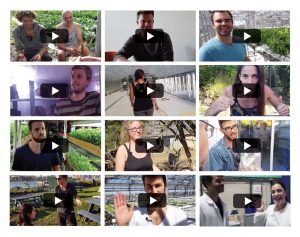12 Steps to become an Urban or Vertical farmer
Los 12 pasos para convertirse en …
The 12 steps to become an urban or vertical farmer are inspirational guidelines with detailed information on how to start your farm. They are a dozen in depth tales about successful pioneers in the urban and vertical farming movement.
They are hours and hours of in depth video interviews, unique video-tours at Urban Farming facilities, structured educational content and a lot of extra information that will help you take steps to become an Urban or Vertical Farmer.
Step 1 – Farming, Vertical Farming & circular economy
An introduction to farming & vertical farming, why should you do it, what is it and how do you do it in a sustainable way
Step 2 – Story and background
Everyone has a different background and in this step you’ll find out how you can use your background to become successful in your Urban or Vertical Farming endeavor
Step 3 – How to chose your crops
To start a farm you need to know what to grow and what to produce. In this step you’ll learn the imporant variables to consider to choose your crops
Step 4 – Business Model
To start a sustainable urban or vertical farm, you need a sustainable business model. In this step you’ll learn that there many innovative ways on how to go about this.
Step 5 – All about growing & technology
Ow science, we love you so. Your crop is a living organism that needs to be understood before you can grow and take care of it. In this step you’ll learn about the science of growing and about the technologies that can be used.
Step 6 – Resources, input & output
This step is a very underestimated part of a business, yet when it comes to sustainability it is extremely important. In this step you’ll learn how you can use your resource-flows to the benefit of your Urban or Vertical farm
Step 7 – Marketing & Customers
Starting a business means you need to know sell something. In this step you’ll learn how to get to know your market, do marketing and keep a good (or bad) relationship with your customers)
Step 8 – Partners or competitors
We’re all in this to make the world a better place, and for that you need to know who your partners and competitors are. In this step you’ll learn how do you go about them and how can they strengthen your business.
Step 9 – Location, Architecture & Agritecture
When it comes to urban & vertical farming architecture is very important. In this step you’ll learn what impact your location and architecture has on your farm. Moreover, you’ll learn what to keep in mind when you integrate agriculture with architecture.
Step 10 – Financing
This step is quite self-explanatory: how do you finance your farm and what is important to keep in mind.
Step 11 – Law and Policy
Laws and policies will affect your farm. In this step you’ll learn how to
Step 12 – Final advice
All the 12 step farmers give you some final advice – soak it up like sponge.
The 12 steps farmers are the heroes and the pioneers that empower themselves while making this world a healthier and more fun place to live in.
- Marion Sourdois and Nicolas Sarlé from Les Sourciers (Hydroponic Farm, France)
- Miles Cretien from Verticulture (CEA Aquaponic farm, New York City)
- Hadrien Velge from Le Champignon de Bruxelles (Mushroom farm, Belgium)
- Sabrina Carvahlo en Gonçalo Cabrita from CoolFarm (CEA solutions, Portugal
- Justine Floquet from Les 13 Blés (Goatfarm, France)
- Andrew Carter and Adam Demartino from Smallhold (Mushroom Farms, New York City)
- Rony Nekkebroeck and Benny Van De Velde from Oogstgoed (CSA Farm, Belgium)
- Scott Carrus from Sky Vegetables (Rooftop Greenhouse, New York City)
- Henry Gordon Smith from Blue Planet Consulting (Urban Farming consultants, New York City)
- Johan Jacobs from Millibeter (Insect farms, Belgium)


